

Compact Muon Solenoid
LHC, CERN
| CMS-PAS-SUS-16-039 | ||
| Search for electroweak production of charginos and neutralinos in multilepton final states in pp collision data at √s= 13 TeV | ||
| CMS Collaboration | ||
| March 2017 | ||
| Abstract: Searches are presented for direct electroweak production of charginos and neutralinos in signatures with two light leptons of the same charge and with three or more leptons including up to two hadronically decaying τ leptons. The results are based on a sample of proton-proton collision data collected at a center-of-mass energy √s= 13 TeV recorded with the CMS detector, corresponding to an integrated luminosity of 35.9 fb−1. The observed event rates are in agreement with expectations from the standard model. These results probe charginos and neutralinos with masses up to values between 225 and 1150 GeV, depending on the model parameters assumed. These results significantly extend the phase space probed with previous searches. | ||
|
Links:
CDS record (PDF) ;
inSPIRE record ;
CADI line (restricted) ;
These preliminary results are superseded in this paper, JHEP 03 (2018) 166. The superseded preliminary plots can be found here. |
||
| Figures & Tables | Summary | Additional Figures & Tables | References | CMS Publications |
|---|
|
Additional information on efficiencies needed for reinterpretation of these results are available here.
Additional technical material for CMS speakers can be found here |
| Figures | |

png pdf |
Figure 1:
Chargino-neutralino pair production with decays mediated by sleptons and sneutrinos, leading to a three-lepton final state. |
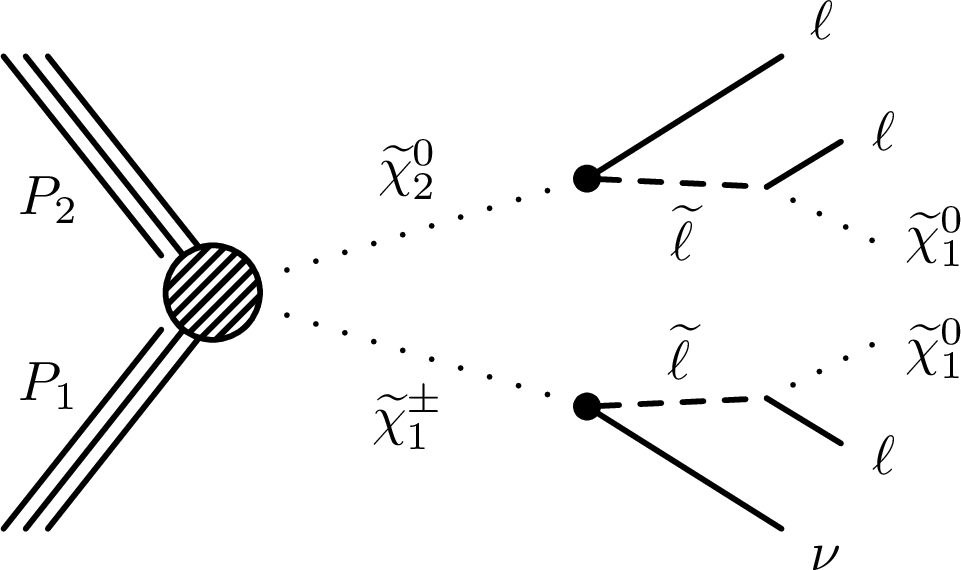
png pdf |
Figure 1-a:
Chargino-neutralino pair production with decays mediated by sleptons and sneutrinos, leading to a three-lepton final state. |

png pdf |
Figure 1-b:
Chargino-neutralino pair production with decays mediated by sleptons and sneutrinos, leading to a three-lepton final state. |

png pdf |
Figure 2:
Chargino-neutralino pair production with the chargino decaying to W and the LSP and the neutralino decaying to (left) a Z boson and the LSP or (right) a H boson and the LSP. |
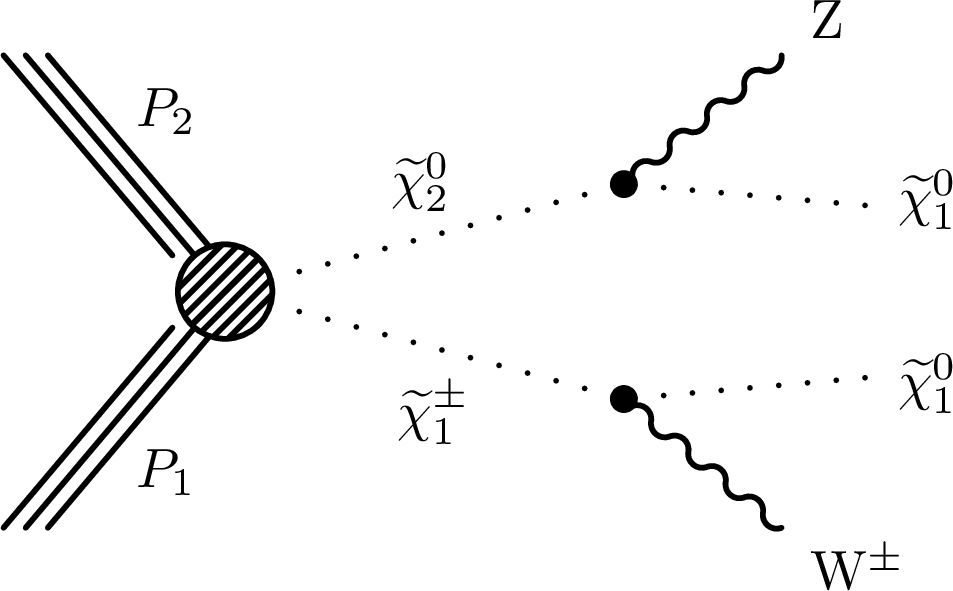
png pdf |
Figure 2-a:
Chargino-neutralino pair production with the chargino decaying to W and the LSP and the neutralino decaying to a Z boson and the LSP. |
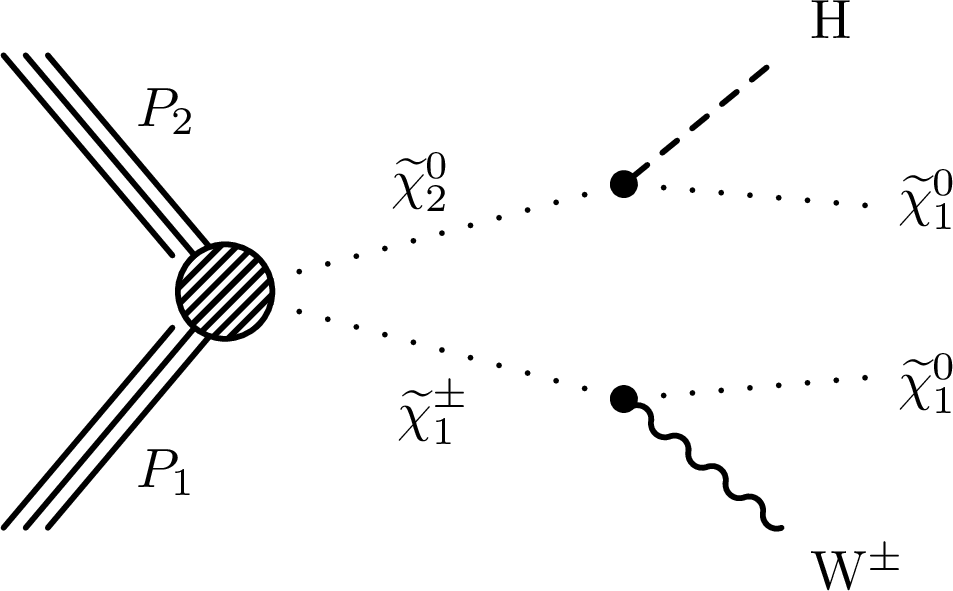
png pdf |
Figure 2-b:
Chargino-neutralino pair production with the chargino decaying to W and the LSP and the neutralino decaying to a H boson and the LSP. |
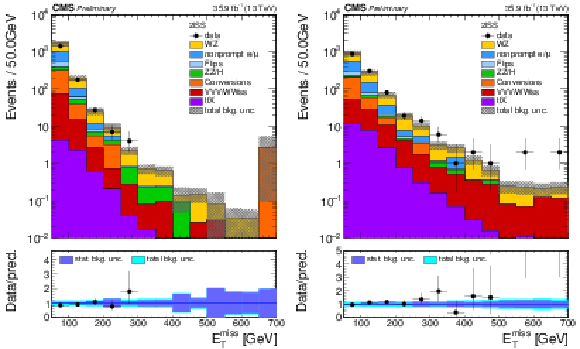
png pdf |
Figure 3:
Distribution of the EmissT in events with 2 same-sign leptons and 0 jets (left) or 1 jet (right). |

png pdf |
Figure 3-a:
Distribution of the EmissT in events with 2 same-sign leptons and 0 jets. |
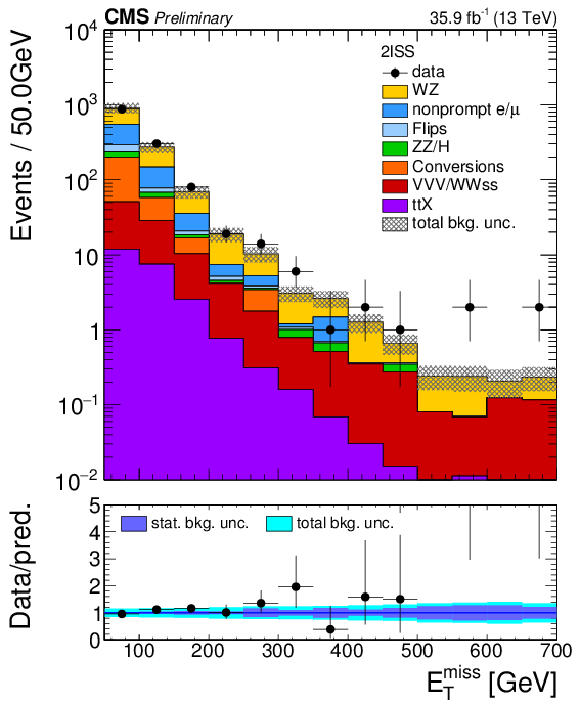
png pdf |
Figure 3-b:
Distribution of the EmissT in events with 2 same-sign leptons and 1 jet. |
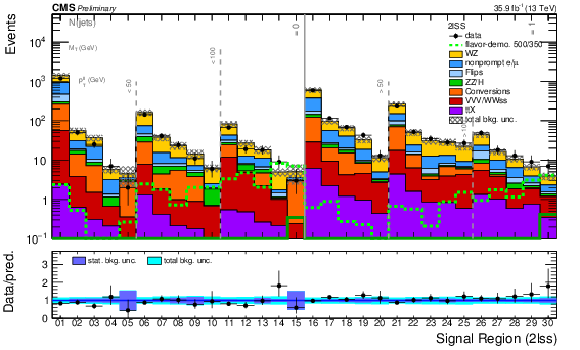
png pdf |
Figure 4:
Expected and observed yields comparison in the same-sign category. |
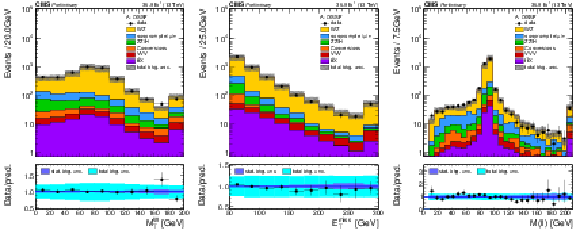
png pdf |
Figure 5:
Distribution of key observables used in the event selection for events entering baseline region A: the transverse mass of the third lepton (left), the EmissT (middle) and the mℓℓ (right) of the OSSF pair. |
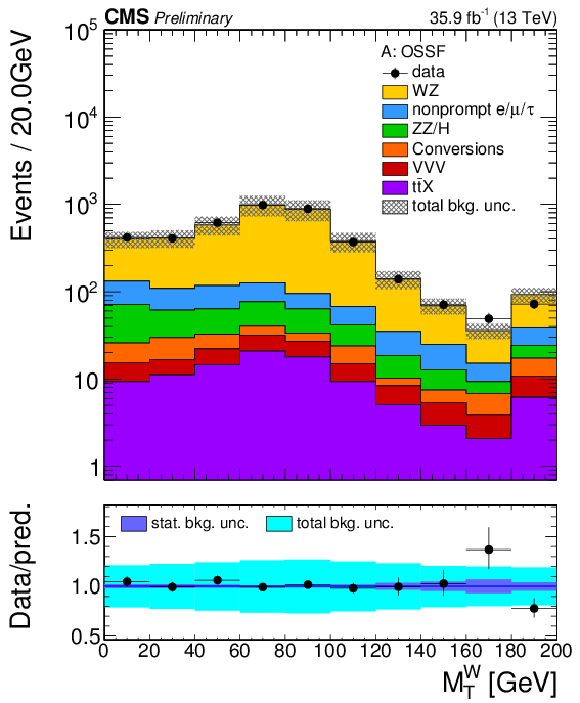
png pdf |
Figure 5-a:
Distribution of a key observable used in the event selection for events entering baseline region A: the transverse mass of the third lepton. |
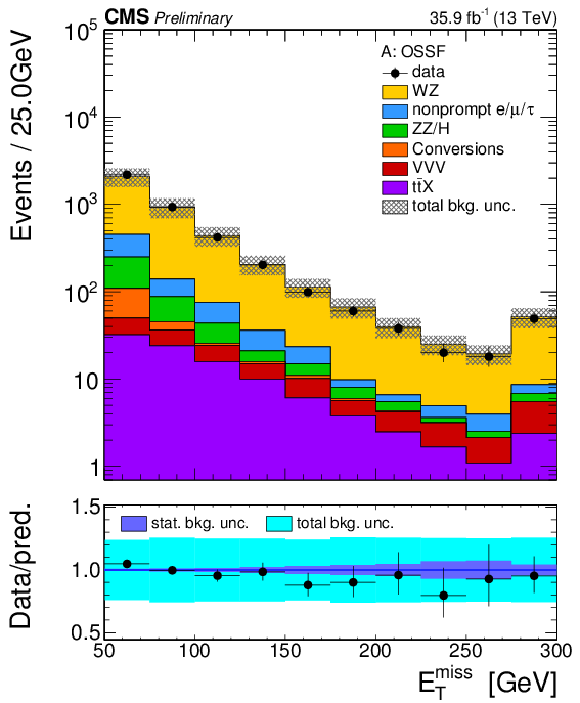
png pdf |
Figure 5-b:
Distribution of a key observable used in the event selection for events entering baseline region A: the EmissT. |
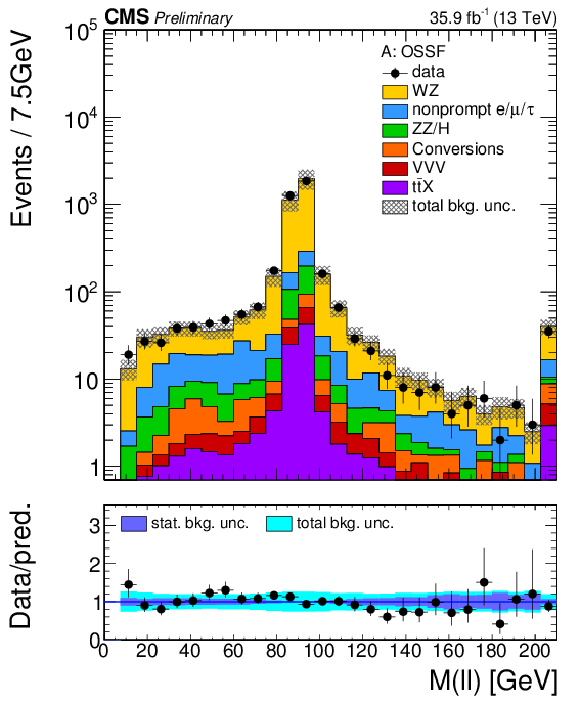
png pdf |
Figure 5-c:
Distribution of a key observable used in the event selection for events entering baseline region A: the mℓℓ of the OSSF pair. |

png pdf |
Figure 6:
Expected and observed yields comparison in category A (top) and category B (bottom) signal regions, i.e. 3 light flavor leptons including at least one OSSF pair (A) or no OSSF pair (B), respectively. |
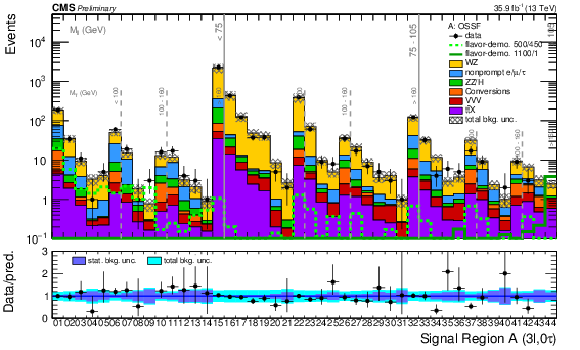
png pdf |
Figure 6-a:
Expected and observed yields comparison in the category A (top) and signal region, i.e. 3 light flavor leptons including at least one OSSF pair. |

png pdf |
Figure 6-b:
Expected and observed yields comparison in the category B (bottom) signal region, i.e. no OSSF pair (B). |
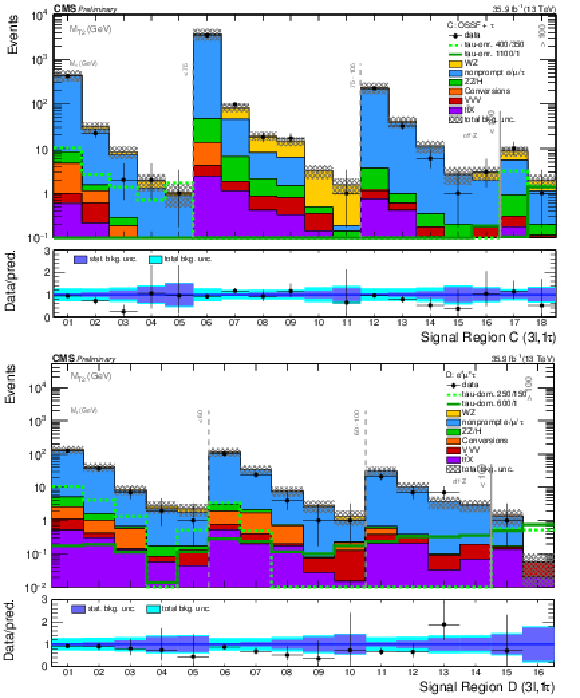
png pdf |
Figure 7:
Expected and observed yields comparison in events with one τh: categories C (top) and D (bottom). |
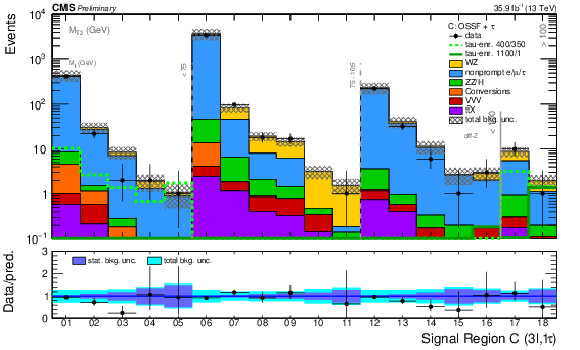
png pdf |
Figure 7-a:
Expected and observed yields comparison in events with one τh: category C. |
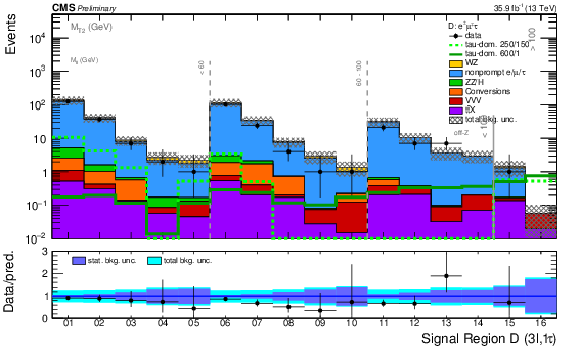
png pdf |
Figure 7-b:
Expected and observed yields comparison in events with one τh: category D. |
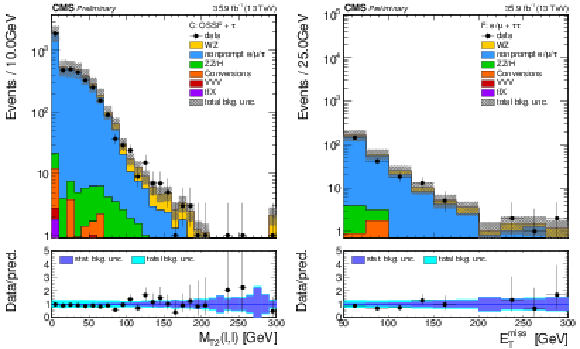
png pdf |
Figure 8:
Distribution of the transverse mass in events with two OSSF light leptons and one hadronic tau (left) and EmissT in events with one light flavor lepton and two hadronic taus. |
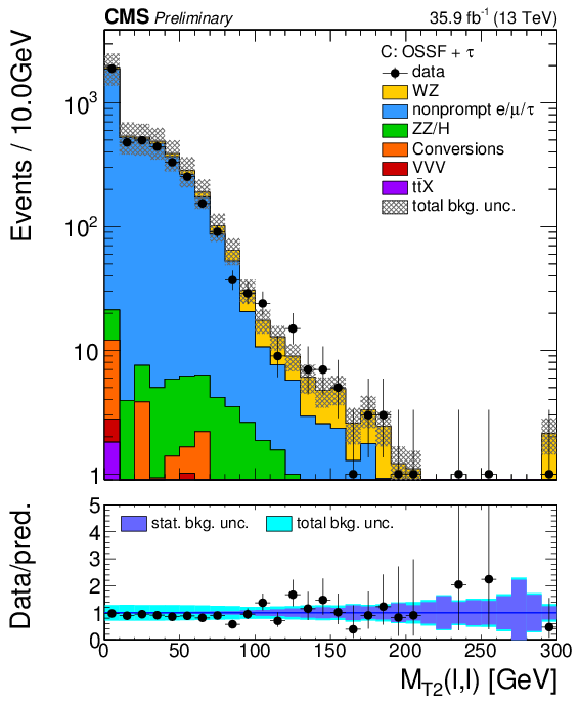
png pdf |
Figure 8-a:
Distribution of the transverse mass in events with two OSSF light leptons and one hadronic tau. |
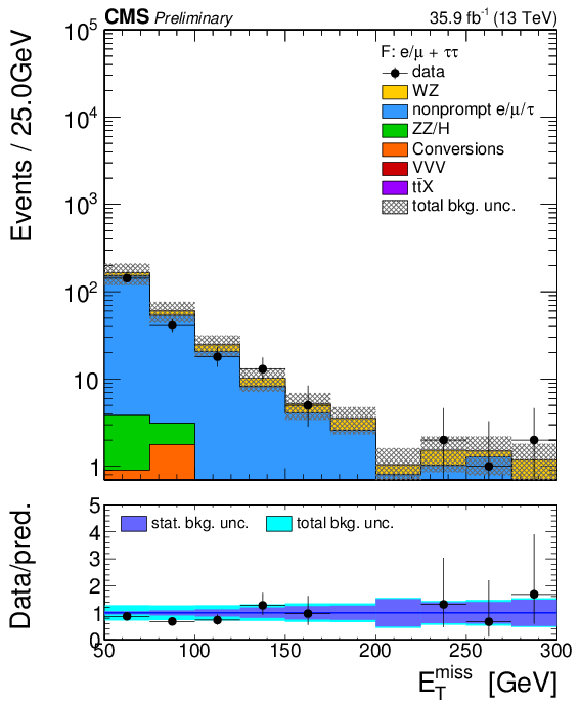
png pdf |
Figure 8-b:
EmissT in events with one light flavor lepton and two hadronic taus. |
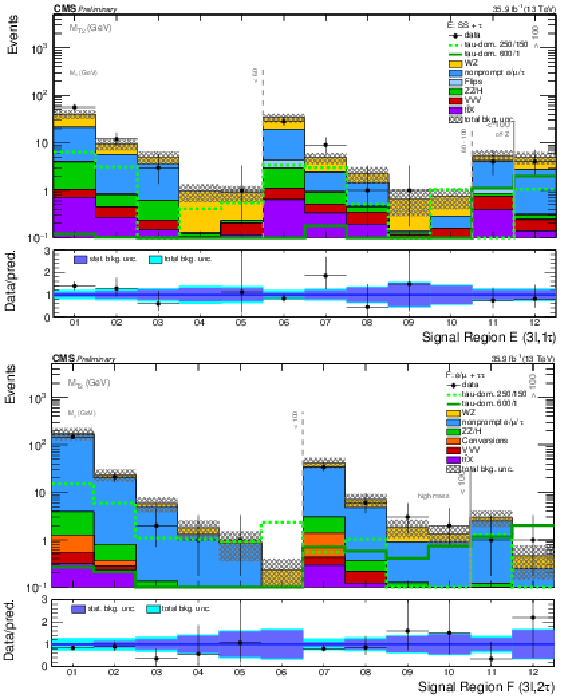
png pdf |
Figure 9:
Expected and observed yields comparison in events one τh: category E (top); and in events with two τh: category F (bottom). |
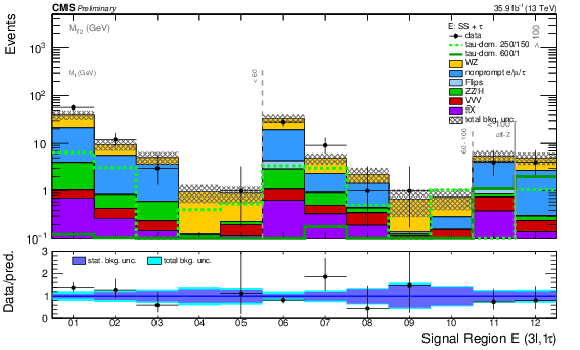
png pdf |
Figure 9-a:
Expected and observed yields comparison in events one τh: category E. |

png pdf |
Figure 9-b:
Expected and observed yields comparison in events with two τh: category F. |
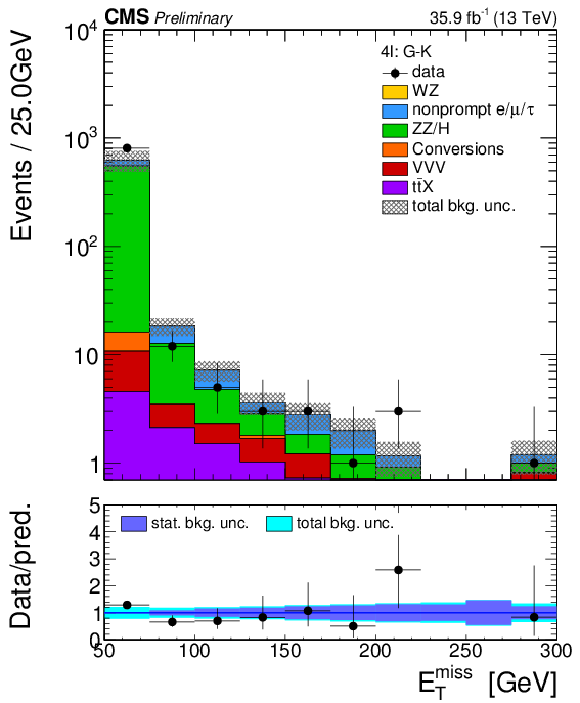
png pdf |
Figure 10:
Distribution of the EmissT in events with 4 or more leptons entering search categories G-K. |
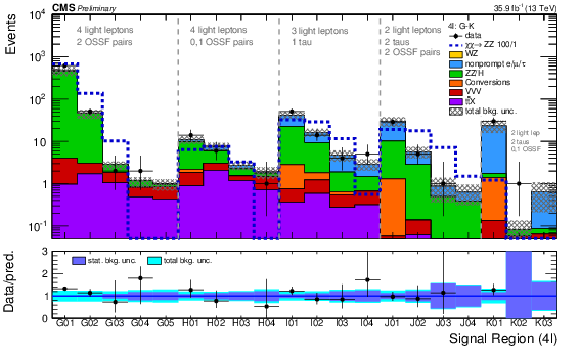
png pdf |
Figure 11:
Expected and observed yields comparison in signal regions with at least four leptons (categories G-K). |
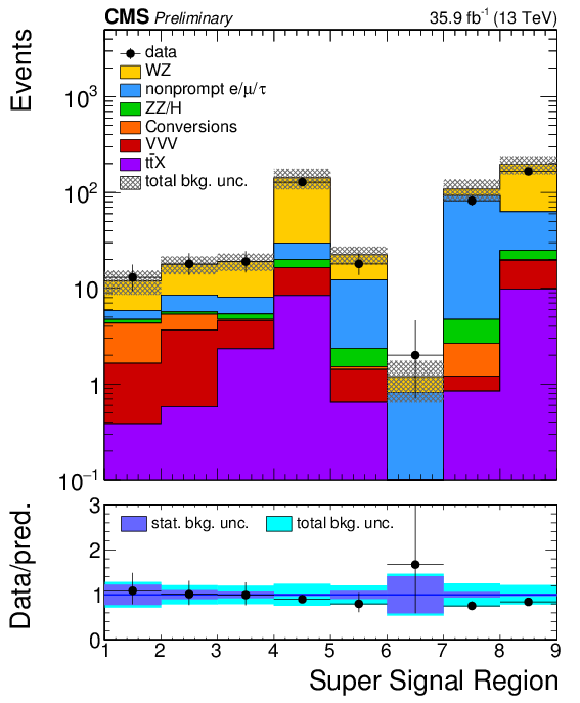
png pdf |
Figure 12:
Expected and observed yields comparison in the aggregated search regions. In this plot, the data-driven charge flip prediction (that is only relevant in the first two bins due to the same-sign dilepton final state) are included in the data-driven nonprompt background prediction. |
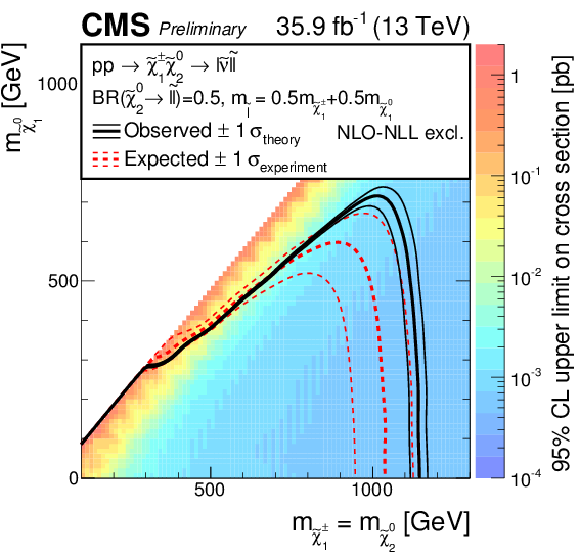
png pdf root |
Figure 13:
Interpretation of the results in the flavor-democratic model with mass parameter x=0.5 obtained with events of category A. The shading in the m˜χ01 versus m˜χ02 (=m˜χ±1) plane indicates the 95% CL upper limit on the chargino-neutralino production cross section times branching fraction. The contours bound the mass regions excluded at 95% CL assuming the NLO+NLL cross sections. The observed, ±1σtheory observed, median expected, and ±1σexperiment expected bounds are shown. |
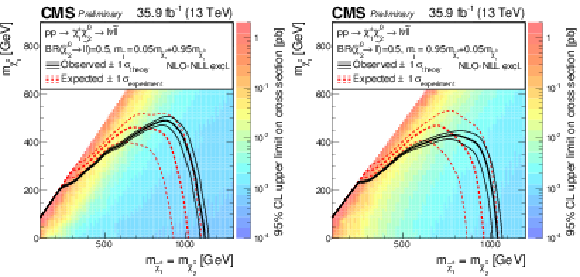
png pdf |
Figure 14:
Interpretation of the results in the flavor-democratic model with mass parameter x= 0.05 (left) and x= 0.95 (right) obtained with the combination of the same-sign category and category A. The shading in this figure are as described in Figure 13. |
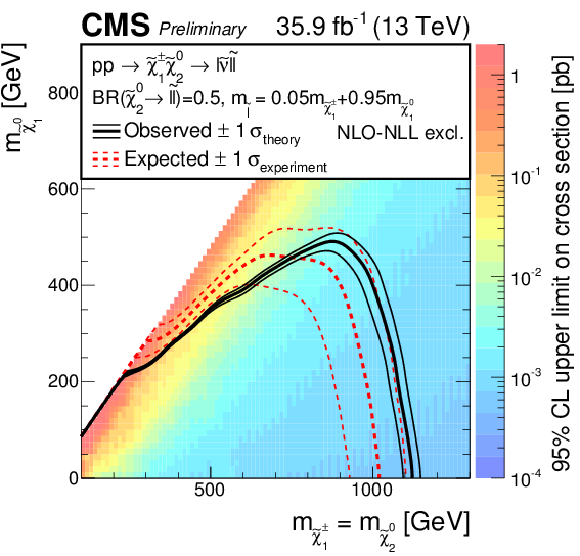
png pdf root |
Figure 14-a:
Interpretation of the results in the flavor-democratic model with mass parameter x= 0.05 obtained with the combination of the same-sign category and category A. The shading in this figure are as described in Fig. 13. |

png pdf root |
Figure 14-b:
Interpretation of the results in the flavor-democratic model with mass parameter x= 0.95 obtained with the combination of the same-sign category and category A. The shading in this figure are as described in Fig. 13. |

png pdf |
Figure 15:
Interpretation of the results in the tau-enriched model with mass parameter x= 0.05 (left), x= 0.5 (center) and x= 0.95 (right) obtained with events of categories A and C. The shading in this figure are as described in Figure 13. |
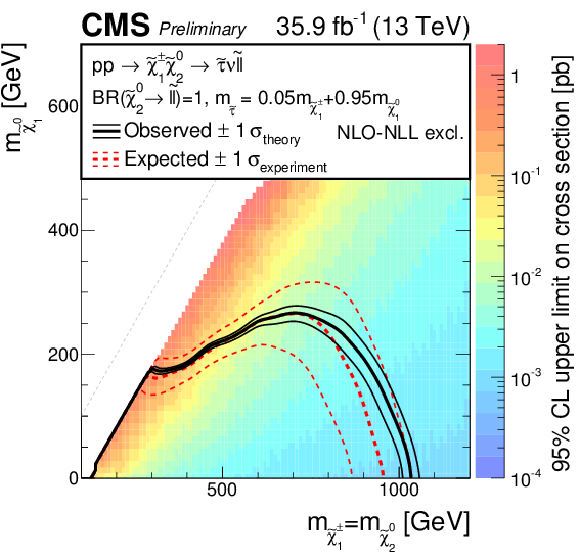
png pdf root |
Figure 15-a:
Interpretation of the results in the tau-enriched model with mass parameter x= 0.05 obtained with events of categories A and C. The shading in this figure are as described in Fig. 13. |
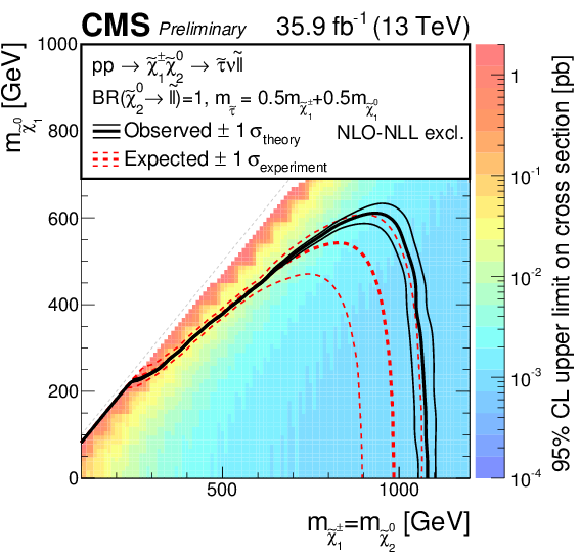
png pdf root |
Figure 15-b:
Interpretation of the results in the tau-enriched model with mass parameter x= 0.5 obtained with events of categories A and C. The shading in this figure are as described in Fig. 13. |
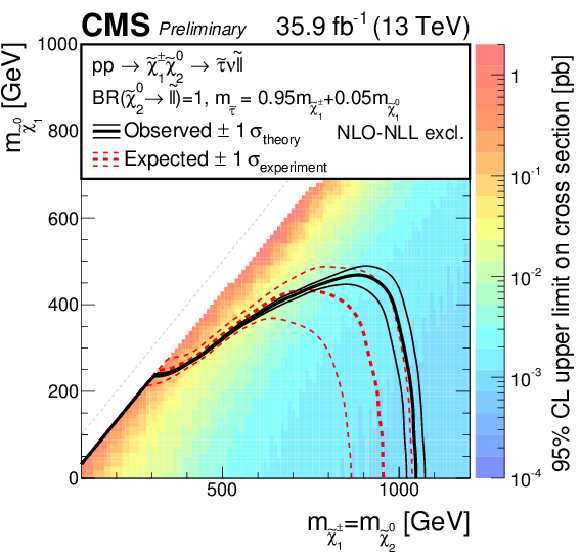
png pdf root |
Figure 15-c:
Interpretation of the results in the tau-enriched model with mass parameter x= 0.95 obtained with events of categories A and C. The shading in this figure are as described in Fig. 13. |

png pdf root |
Figure 16:
Interpretation of the results in the tau-dominated model with mass parameter x=0.5 obtained with events of category B-F. The shading in this figure are as described in Figure 13. |

png pdf |
Figure 17:
Interpretation of the results in the ˜χ±1˜χ02→WZ (left) model obtained with events of category A and the ˜χ±1˜χ02→WH (right) model obtained with events of all categories (same-sign, trilepton and four lepton). The shading in this figure are as described in Figure 13. |

png pdf root |
Figure 17-a:
Interpretation of the results in the ˜χ±1˜χ02→WZ model obtained with events of category A. The shading in this figure are as described in Fig. 13. |
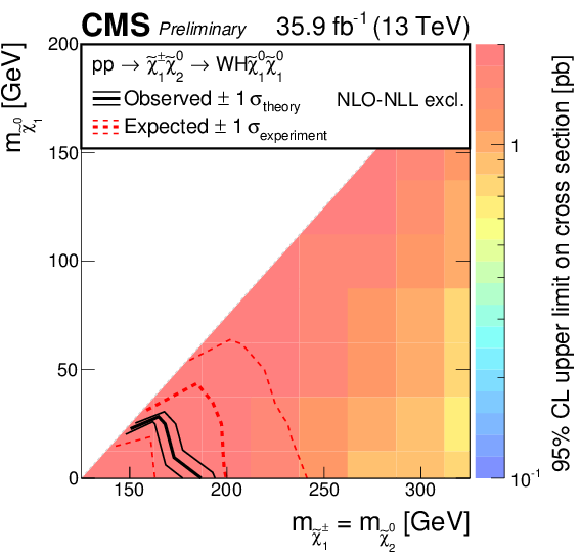
png pdf root |
Figure 17-b:
Interpretation of the results in the ˜χ±1˜χ02→WH model obtained with events of all categories (same-sign, trilepton and four lepton). The shading in this figure are as described in Fig. 13. |
| Tables | |

png pdf |
Table 1:
Search regions for events with two same-sign light flavor leptons. |
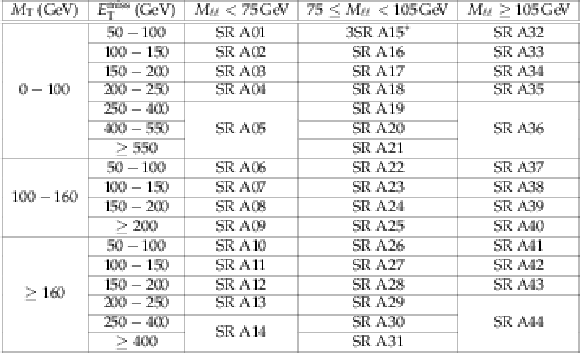
png pdf |
Table 2:
Search regions for events with three e or μ that form at least one OSSF pair. Search region SR A15∗ is contained within a control region of the analysis and is not used in the interpretation. |

png pdf |
Table 3:
Search regions for events with three e or μ that do not form an OSSF pair. |

png pdf |
Table 4:
Search region definition for events with two e or μ forming an OSSF pair and one τh candidate. Regions where there is a Z boson candidate are not split into MT2 categories. |

png pdf |
Table 5:
Search region definition for events with one e and one μ of opposite sign, and one τh candidate. |

png pdf |
Table 6:
Search region definition for events with two e or μ of same sign and one τh candidate. |
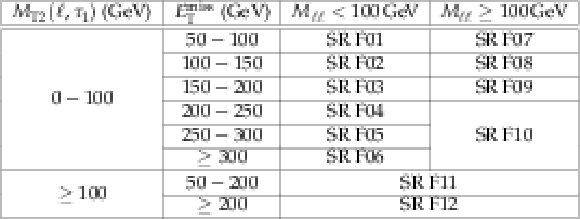
png pdf |
Table 7:
Search region definition for events with one electron or muon and two τh candidates. |

png pdf |
Table 8:
Search region definition for events with four or more leptons. |

png pdf |
Table 9:
Definition of the aggregated regions for multilepton and two same-sign leptons final states. |
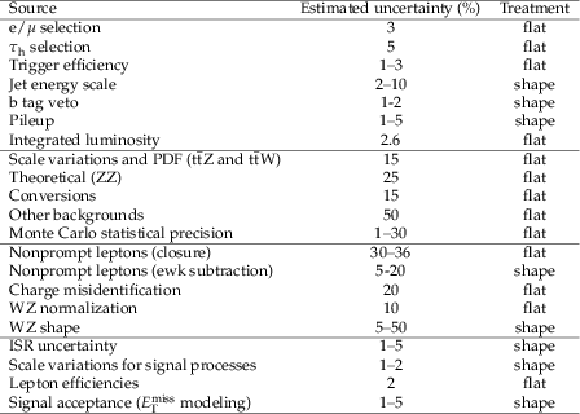
png pdf |
Table 10:
Summary of systematic uncertainties in the event yields in the search regions. The upper group lists uncertainties related to experimental effects for all processes whose yield is estimated from simulation; the middle group lists uncertainties in these yields related to the event simulation process itself. The third group lists uncertainties for background processes whose yield is estimated from data. Finally, the last group describes uncertainties related to the extraction of the signal acceptance in MC simulation. |

png pdf |
Table 11:
Same-sign category: Expected and observed yields in events with two same-sign light leptons. The uncertainty denotes the total uncertainty on the result. |

png pdf |
Table 12:
Category A: Expected and observed yields in events with three e or μ that form one OSSF pair. The uncertainty denotes the total uncertainty on the result. |

png pdf |
Table 13:
Category B: Expected and observed yields in events with three e or μ that do not form an OSSF pair. The uncertainty denotes the total uncertainty on the result. |

png pdf |
Table 14:
Category C: Expected and observed yields in events with two e or μ forming and OSSF pair and one τh. The uncertainty denotes the total uncertainty on the result. |

png pdf |
Table 15:
Category D: Expected and observed yields in events with an opposite-sign eμ pair and one τh. The uncertainty denotes the total uncertainty on the result. |

png pdf |
Table 16:
Category E: Expected and observed yields in events with one same-sign e or μ and one τh. The uncertainty denotes the total uncertainty on the result. |
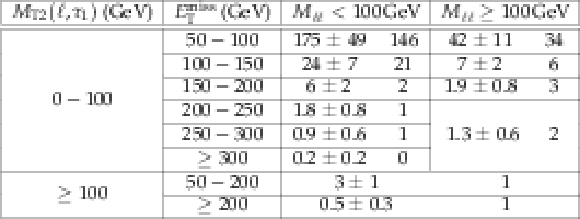
png pdf |
Table 17:
Category F: Expected and observed yields in events with one e or μ and two τh. The uncertainty denotes total uncertainty on the result. |

png pdf |
Table 18:
Categories G-K: Expected and observed yields in the 4ℓ category of the analysis. The uncertainty denotes the total uncertainty on the result. |

png pdf |
Table 19:
Expected and observed yields in the aggregated signal defined in Section {sec:regionsSSR}. The uncertainty denotes the total uncertainty on the result. |
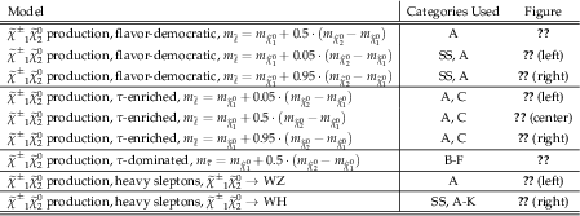
png pdf |
Table 20:
Summary of the interpretations of the results using different models . |
| Summary |
|
Results are presented of a search for new physics in same-sign dilepton, trilepton, and four-lepton events containing up to two hadronically decaying τ leptons in pp collision data at √s= 13 TeV, recorded with the CMS detector at the LHC and corresponding to an integrated luminosity of 35.9 fb−1. The data are divided into categories based on the number, charge, and flavor of the leptons, and subdivided into various kinematic regions to be sensitive to a broad range of electroweakly produced new particles. No significant deviation from the standard model expectations is observed. The results are used to set limits on various simplified models of supersymmetry that entail the production of superpartners of gauge or Higgs bosons (charginos and neutralinos). Specifically we consider chargino-neutralino pair production, an electroweak process that is expected to have the largest cross section. The resulting signal topologies depend on the masses of the lepton superpartners (sleptons). Models with light left-handed sleptons lead to enhanced branching fractions to final states with three leptons. Depending on the left-right mixing and flavor of these sleptons, the results imply limits on the masses of charginos and neutralinos up to 1150 GeV for the flavor-democratic scenario, extending the reach of our previous result [15] by about 450 GeV. In these models, searches in the same-sign dilepton final state enhance the sensitivity in the experimentally challenging region with small mass difference between the produced gauginos and the lightest supersymmetric particle that are inaccessible with the trilepton signature. In the case in which the chargino and neutralino decay ultimately to three τ leptons and the lightest supersymmetric particle, masses of charginos up to 400 GeV are probed. The most challenging scenarios considered involve the direct decay of gauginos to the lightest supersymmetric particle via W and Z or Higgs bosons. For the final states with W and Z bosons, chargino masses up to 475 GeV are excluded, improving the previous reach by 200 GeV. In the case of neutralino decay via a Higgs boson, only masses up to 225 GeV can be excluded. |
| Additional Figures | |
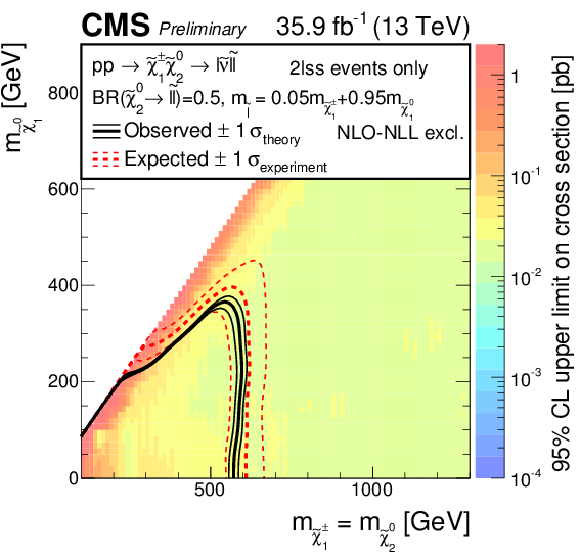
png pdf root |
Additional Figure 1:
Interpretation of the results in the flavor-democratic model with mass parameter x= 0.05 obtained with events of the same-sign category. |
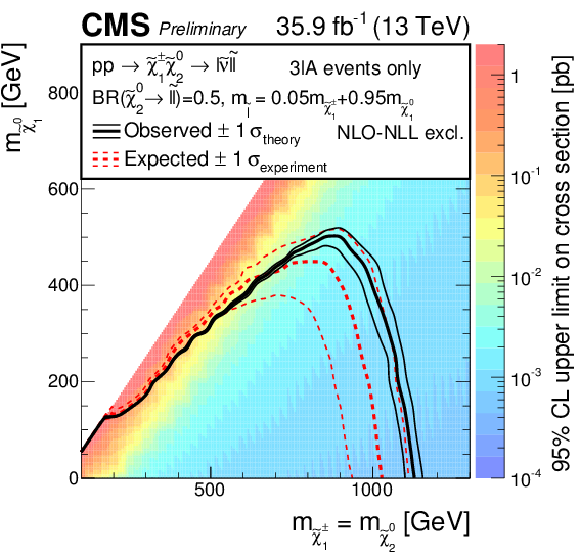
png pdf root |
Additional Figure 2:
Interpretation of the results in the flavor-democratic model with mass parameter x= 0.05 obtained with events of the 3lA category. |
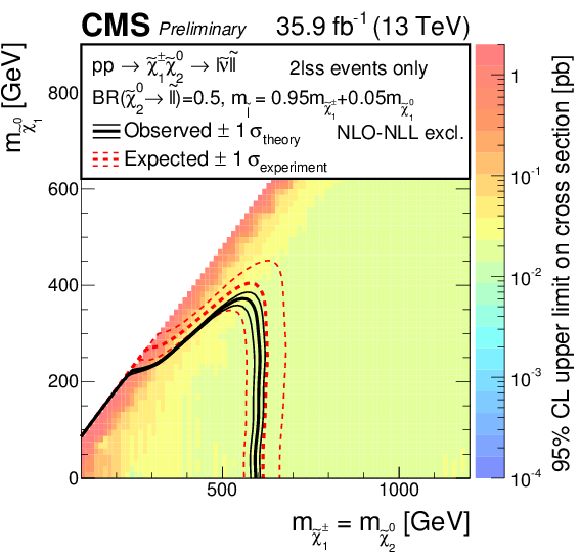
png pdf root |
Additional Figure 3:
Interpretation of the results in the flavor-democratic model with mass parameter x= 0.95 obtained with events of the same-sign category. |
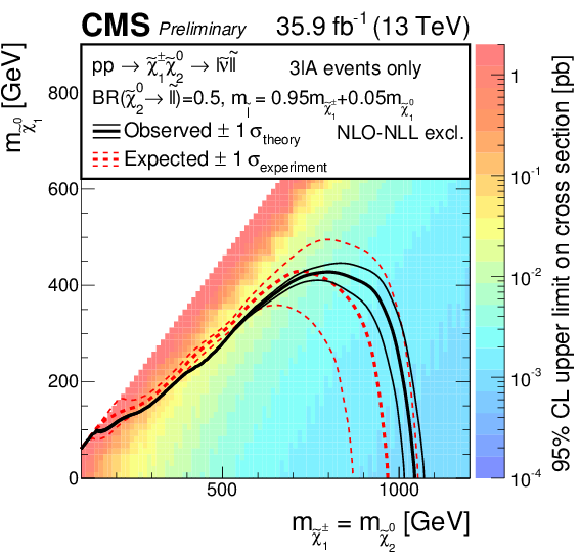
png pdf root |
Additional Figure 4:
Interpretation of the results in the flavor-democratic model with mass parameter x= 0.95 obtained with events of the 3lA category. |
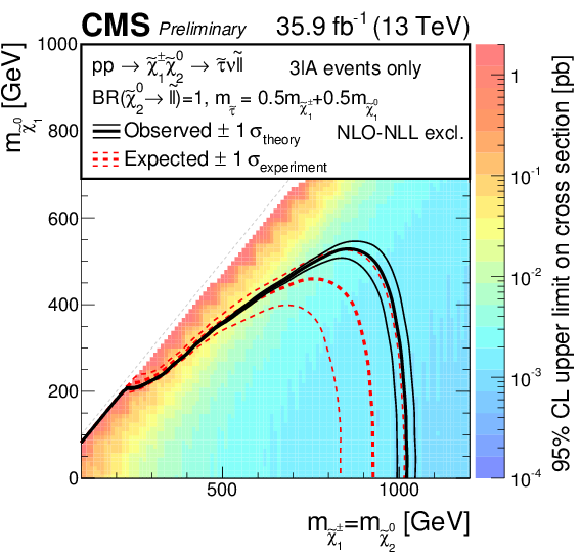
png pdf root |
Additional Figure 5:
Interpretation of the results in the tau-enriched model with mass parameter x= 0.5 obtained with events of the 3lA category. |
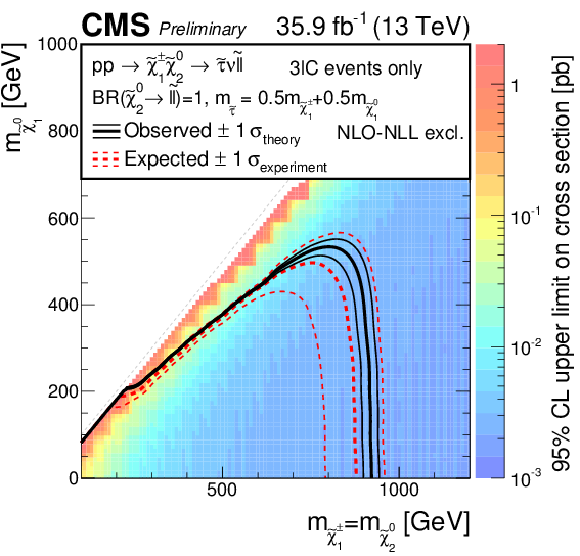
png pdf root |
Additional Figure 6:
Interpretation of the results in the tau-enriched model with mass parameter x= 0.5 obtained with events of the 3lC category. |
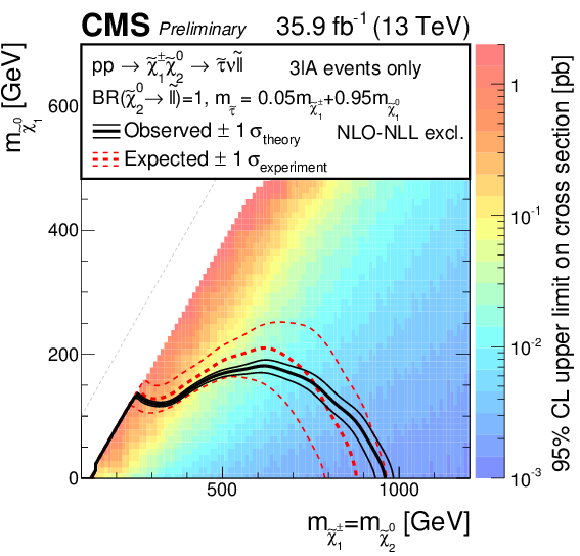
png pdf root |
Additional Figure 7:
Interpretation of the results in the tau-enriched model with mass parameter x= 0.05 obtained with events of the 3lA category. |
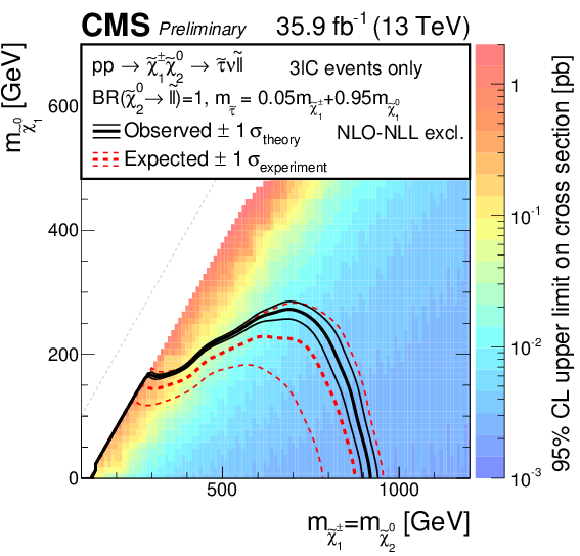
png pdf root |
Additional Figure 8:
Interpretation of the results in the tau-enriched model with mass parameter x= 0.05 obtained with events of the 3lC category. |
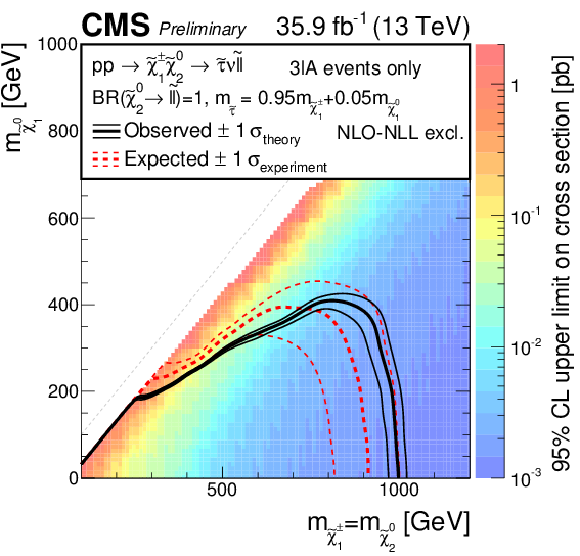
png pdf root |
Additional Figure 9:
Interpretation of the results in the tau-enriched model with mass parameter x= 0.95 obtained with events of the 3lA category. |

png pdf root |
Additional Figure 10:
Interpretation of the results in the tau-enriched model with mass parameter x= 0.95 obtained with events of the 3lC category. |

png pdf root |
Additional Figure 11:
Interpretation of the results in the tau-dominated model with mass parameter x= 0.5 obtained with events of the 3lB category. |
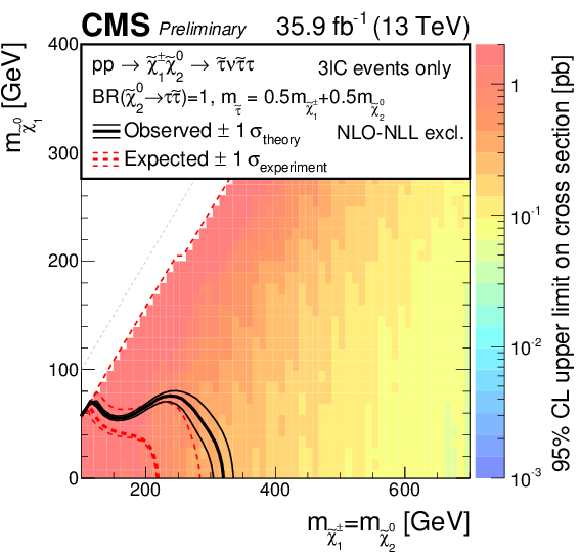
png pdf root |
Additional Figure 12:
Interpretation of the results in the tau-dominated model with mass parameter x= 0.5 obtained with events of the 3lC category. |
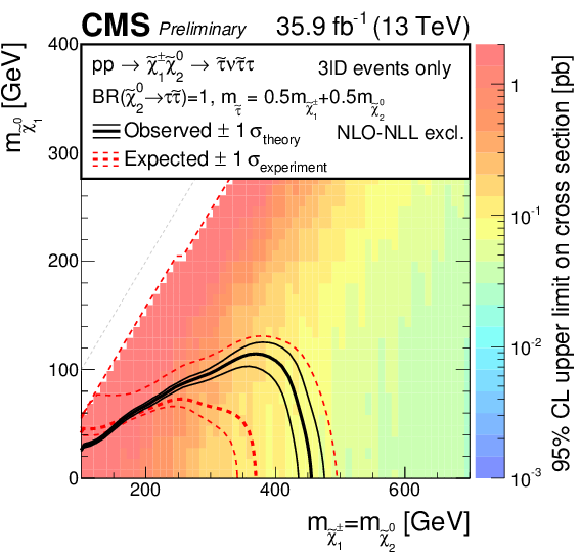
png pdf root |
Additional Figure 13:
Interpretation of the results in the tau-dominated model with mass parameter x= 0.5 obtained with events of the 3lD category. |

png pdf root |
Additional Figure 14:
Interpretation of the results in the tau-dominated model with mass parameter x= 0.5 obtained with events of the 3lE category. |
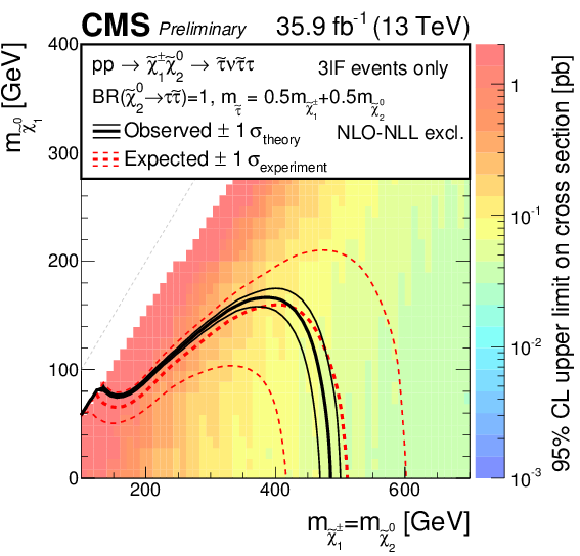
png pdf root |
Additional Figure 15:
Interpretation of the results in the tau-dominated model with mass parameter x= 0.5 obtained with events of the 3lF category. |
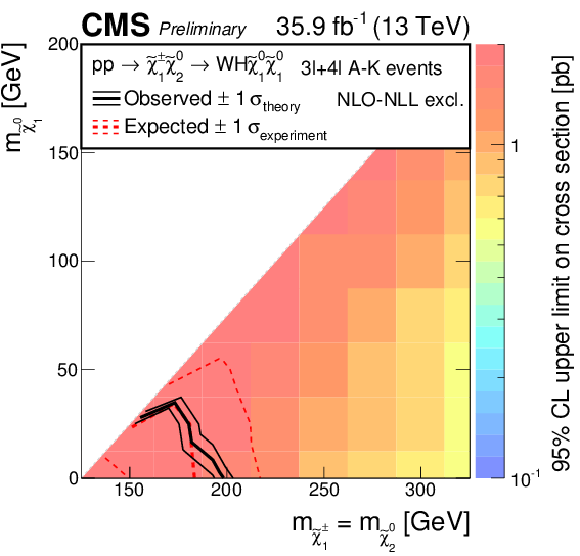
png pdf root |
Additional Figure 16:
Interpretation of the results in the TChiWH model obtained with events of the 3l categories A-F and the 4l categories G-K. |
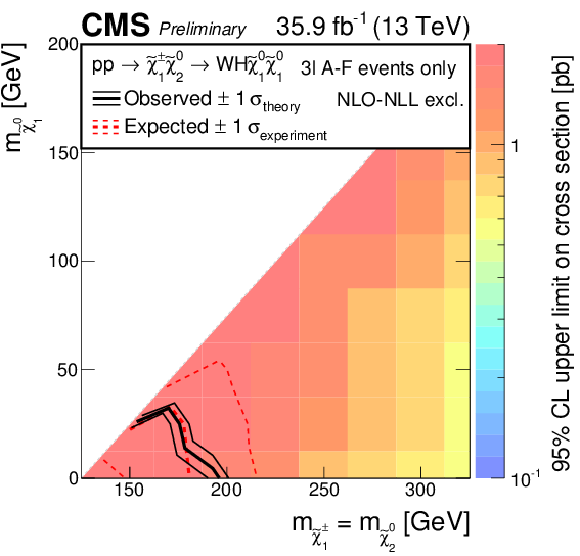
png pdf root |
Additional Figure 17:
Interpretation of the results in the TChiWH model obtained with events of the 3l categories A-F. |
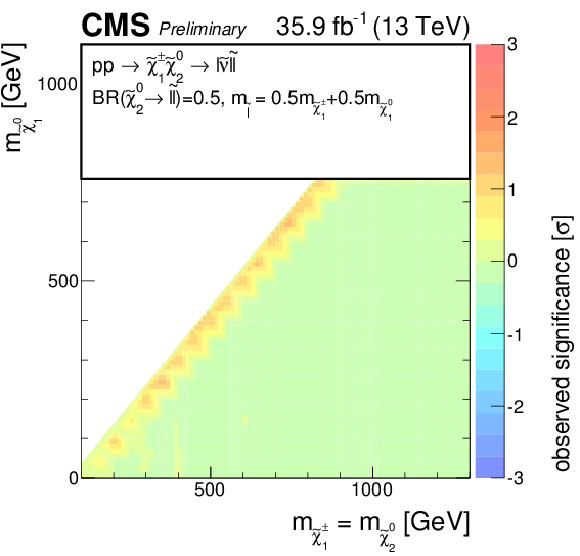
png pdf root |
Additional Figure 18:
Observed local significance in the flavor-democratic model with mass parameter x= 0.5 obtained with 3lA events. |
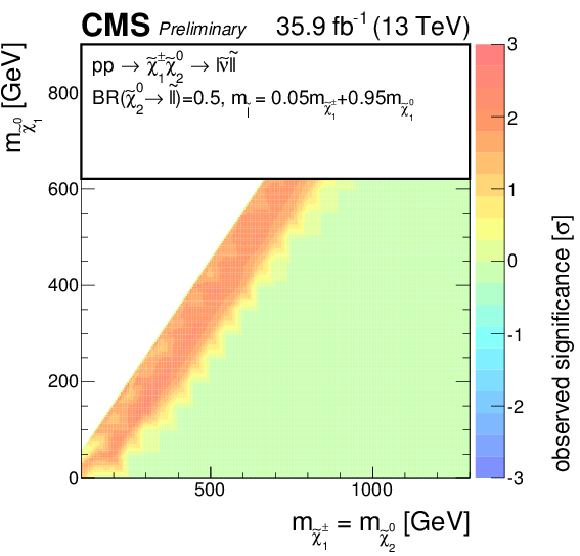
png pdf root |
Additional Figure 19:
Observed local significance in the flavor-democratic model with mass parameter x= 0.05 obtained with the combination of 2lss and 3lA events. |
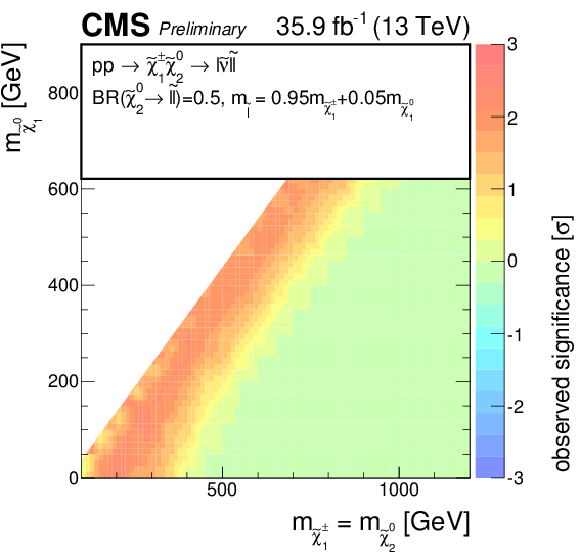
png pdf root |
Additional Figure 20:
Observed local significance in the flavor-democratic model with mass parameter x= 0.95 obtained with the combination of 2lss and 3lA events. |
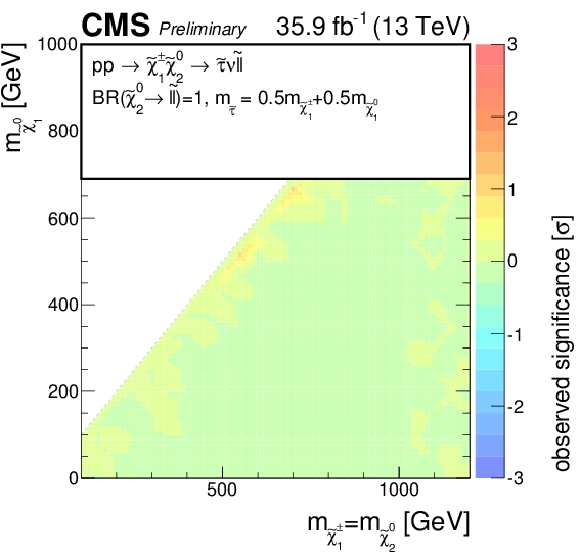
png pdf root |
Additional Figure 21:
Observed local significance in the tau-enriched model with mass parameter x= 0.5 obtained with the combination of 3lA and 3lC events. |
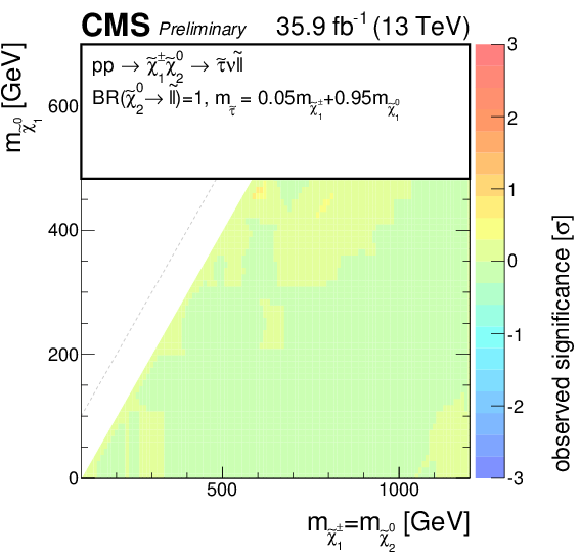
png pdf root |
Additional Figure 22:
Observed local significance in the tau-enriched model with mass parameter x= 0.05 obtained with the combination of 3lA and 3lC events. |
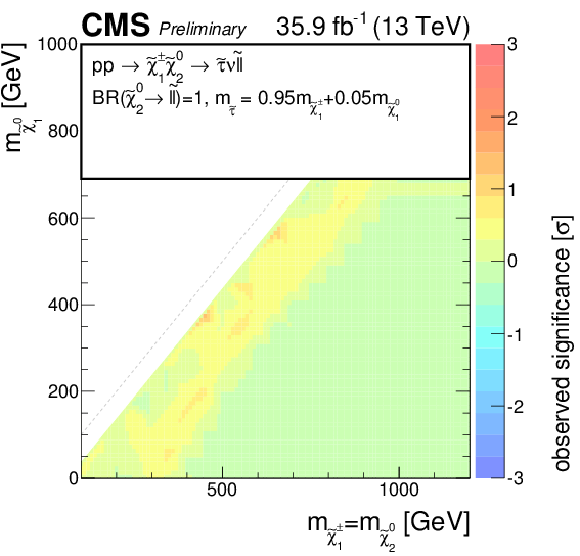
png pdf root |
Additional Figure 23:
Observed local significance in the tau-enriched model with mass parameter x= 0.95 obtained with the combination of 3lA and 3lC events. |
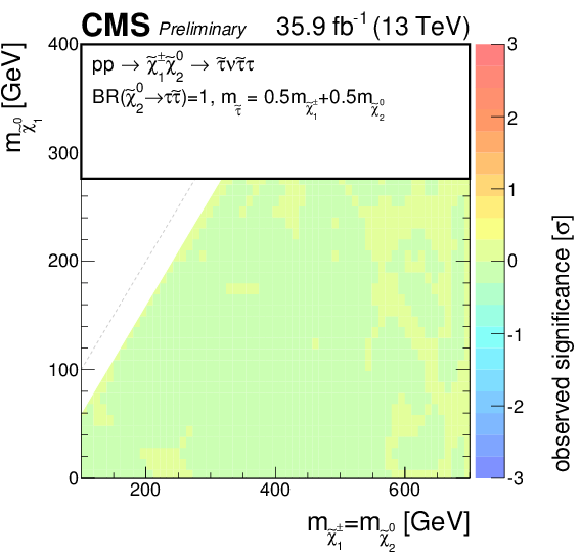
png pdf root |
Additional Figure 24:
Observed local significance in the tau-dominated model obtained with events of the 3lB, 3lC, 3lD, 3lE and 3lF categories. |

png pdf root |
Additional Figure 25:
Observed local significance in the ˜χ±1˜χ02→WZ model obtained with events of category 3lA. |
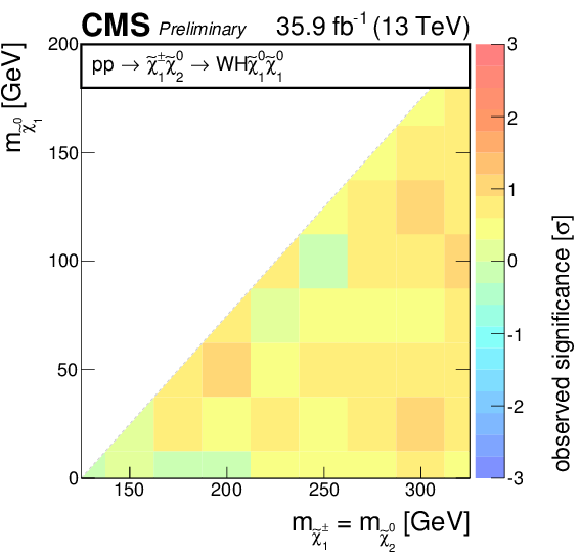
png pdf root |
Additional Figure 26:
Observed local significance in the ˜χ±1˜χ02→WH model obtained with all events of all categories 2lss, 3lA-3lF and 4lG-4lK. |
| Additional Tables | |
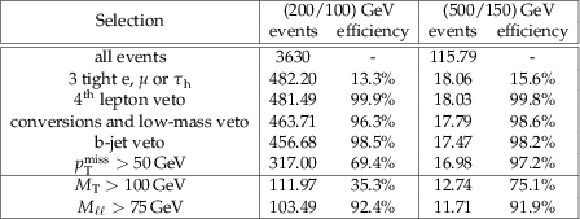
png pdf |
Additional Table 1:
Cut-flow for the trilepton channel for a compressed (m˜χ02= 200 GeV, m˜χ01= 100 GeV, production cross section 1.8 pb) and an uncompressed mass point (m˜χ02= 500 GeV, m˜χ01= 150 GeV, production cross section 0.046 pb) for the ˜χ±1˜χ02→WZ˜χ01˜χ01 model from which one expects three hard and isolated light flavor leptons in the final state. The yields correspond to the integrated luminosity of 35.9 fb−1. |
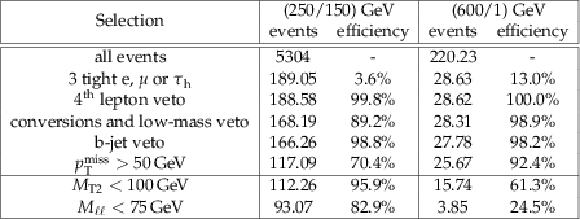
png pdf |
Additional Table 2:
Cut-flow for the trilepton channel for a compressed (m˜χ02= 250 GeV, m˜χ01= 150 GeV, production cross section 0.78 pb) and an uncompressed mass point (m˜χ02= 600 GeV, m˜χ01= 1 GeV, production cross section 0.020 pb) for the τ-dominated model from which one expects three hard and isolated taus in the final state. The yields correspond to the integrated luminosity of 35.9 fb−1. |

png pdf |
Additional Table 3:
Cut-flow for the same-sign dilepton channel for a compressed mass point (m˜χ02= 500 GeV, m˜χ01= 350 GeV, production cross section 0.046 pb) for the flavor-democratic model with mass parameters x= 0.05 and x= 0.5 where m˜ℓ=m˜χ01+x⋅(m˜χ02−m˜χ01). The yields correspond to the integrated luminosity of 35.9 fb−1. |
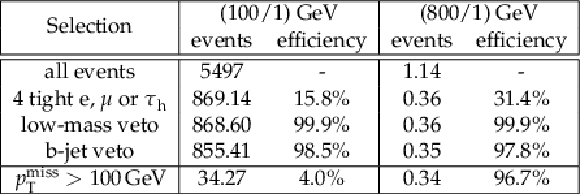
png pdf |
Additional Table 4:
Cut-flow for the four-lepton channel for a compressed (m˜χ01= 100 GeV, m˜G= 1 GeV, production cross section 16.8 pb) and an uncompressed mass point (m˜χ01= 800 GeV, m˜G= 1 GeV, production cross section 0.0035 pb) for the ˜χ0i˜χ0j→ZZ˜G˜G model from which one expects four hard and isolated light flavor leptons in the final state. The yields correspond to the integrated luminosity of 35.9 fb−1. |
| References | ||||
| 1 | ATLAS Collaboration | Observation of a new particle in the search for the Standard Model Higgs boson with the ATLAS detector at the LHC | PLB 716 (2012) 1 | 1207.7214 |
| 2 | CMS Collaboration | Observation of a new boson at a mass of 125 GeV with the CMS experiment at the LHC | PLB 716 (2012) 30 | CMS-HIG-12-028 1207.7235 |
| 3 | CMS Collaboration | Observation of a new boson with mass near 125 GeV in pp collisions at √s= 7 and 8 TeV | JHEP 06 (2013) 081 | CMS-HIG-12-036 1303.4571 |
| 4 | P. Ramond | Dual theory for free fermions | PRD 3 (1971) 2415 | |
| 5 | \relax Yu. A. Golfand and E. P. Likhtman | Extension of the algebra of Poincare group generators and violation of P invariance | JEPTL 13 (1971) 323.[Pisma Zh. Eksp. Teor. Fiz. \bf 13 (1971) 452] | |
| 6 | A. Neveu and J. H. Schwarz | Factorizable dual model of pions | Nucl. Phys. B 31 (1971) 86 | |
| 7 | D. V. Volkov and V. P. Akulov | Possible universal neutrino interaction | JEPTL 16 (1972) 438.[Pisma Zh. Eksp. Teor. Fiz. \bf 16 (1972) 621] | |
| 8 | J. Wess and B. Zumino | A lagrangian model invariant under supergauge transformations | PLB 49 (1974) 52 | |
| 9 | J. Wess and B. Zumino | Supergauge transformations in four-dimensions | Nucl. Phys. B 70 (1974) 39 | |
| 10 | P. Fayet | Supergauge invariant extension of the Higgs mechanism and a model for the electron and its neutrino | Nucl. Phys. B 90 (1975) 104 | |
| 11 | H. P. Nilles | Supersymmetry, supergravity and particle physics | PR 110 (1984) 1 | |
| 12 | S. P. Martin | A supersymmetry primer | in Perspectives on Supersymmetry II, G. L. Kane, ed., p. 1 2010 | hep-ph/9709356 |
| 13 | ATLAS Collaboration | Summary of the ATLAS experiment's sensitivity to supersymmetry after LHC Run 1 -- interpreted in the phenomenological MSSM | JHEP 10 (2015) 134 | 1508.06608 |
| 14 | CMS Collaboration | Phenomenological MSSM interpretation of CMS searches in pp collisions at √s= 7 and 8 TeV | JHEP 10 (2016) 129 | CMS-SUS-15-010 1606.03577 |
| 15 | CMS Collaboration | Searches for electroweak production of charginos, neutralinos, and sleptons decaying to leptons and W, Z, and Higgs bosons in pp collisions at 8 TeV | EPJC 74 (2014) 3036 | CMS-SUS-13-006 1405.7570 |
| 16 | CMS Collaboration | Searches for electroweak neutralino and chargino production in channels with Higgs, Z, and W bosons in pp collisions at 8 TeV | PRD 90 (2014) 092007 | CMS-SUS-14-002 1409.3168 |
| 17 | ATLAS Collaboration | Search for the electroweak production of supersymmetric particles in √s= 8 TeV pp collisions with the ATLAS detector | PRD 93 (2016) 052002 | 1509.07152 |
| 18 | CMS Collaboration | Search for supersymmetry in the multijet and missing transverse momentum final state in pp collisions at 13 TeV | PLB 758 (2016) 152 | CMS-SUS-15-002 1602.06581 |
| 19 | CMS Collaboration | Search for new physics with the MT2 variable in all-jets final states produced in pp collisions at √s= 13 TeV | JHEP 10 (2016) 006 | CMS-SUS-15-003 1603.04053 |
| 20 | CMS Collaboration | Search for supersymmetry in pp collisions at √s= 13 TeV in the single-lepton final state using the sum of masses of large-radius jets | JHEP 08 (2016) 122 | CMS-SUS-15-007 1605.04608 |
| 21 | CMS Collaboration | Search for new physics in same-sign dilepton events in proton-proton collisions at √s=13TeV | EPJC 76 (2016) 439 | CMS-SUS-15-008 1605.03171 |
| 22 | ATLAS Collaboration | Search for squarks and gluinos in final states with jets and missing transverse momentum at √s= 13 TeV with the ATLAS detector | EPJC 76 (2016) 392 | 1605.03814 |
| 23 | ATLAS Collaboration | Search for gluinos in events with an isolated lepton, jets and missing transverse momentum at √s= 13 TeV with the ATLAS detector | EPJC 76 (2016) 565 | 1605.04285 |
| 24 | ATLAS Collaboration | Search for pair production of gluinos decaying via stop and sbottom in events with b-jets and large missing transverse momentum in pp collisions at √s= 13 TeV with the ATLAS detector | PRD94 (2016), no. 3, 032003 | 1605.09318 |
| 25 | CMS Collaboration | Search for electroweak SUSY production in multilepton final states in pp collisions at √s= 13 TeV with 12.9/fb | CMS-PAS-SUS-16-024 | CMS-PAS-SUS-16-024 |
| 26 | ATLAS Collaboration | Search for supersymmetry with two and three leptons and missing transverse momentum in the final state at √s= 13 TeV with the ATLAS detector | ATLAS Conference Note ATLAS-CONF-2016-096, CERN | |
| 27 | D. Alves et al. | Simplified models for LHC new physics searches | JPG 39 (2012) 105005 | 1105.2838 |
| 28 | CMS Collaboration | The CMS experiment at the CERN LHC | JINST 3 (2008) S08004 | CMS-00-001 |

|
Compact Muon Solenoid LHC, CERN |

|

|

|

|

|

|